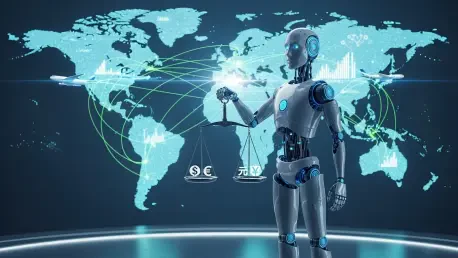Imagine a world where international trade operates with unprecedented speed and precision, where small businesses in remote regions secure funding as easily as multinational corporations, and where trade barriers like language and logistics dissolve almost overnight. This is not a distant dream but a tangible reality unfolding through the power of artificial intelligence (AI). As of 2025, AI is rapidly transforming the landscape of global trade, driving efficiency, slashing costs, and reshaping economic dynamics across borders. This review delves into the core features, real-world performance, and broader implications of AI as a game-changing technology in trade operations, drawing on the latest insights and trends.
Key Features of AI in Trade Operations
Enhancing Efficiency and Decision-Making
At the heart of AI’s impact on global trade lies its ability to streamline operations and sharpen decision-making. Advanced algorithms, powered by machine learning, analyze vast datasets to predict market trends, optimize supply chains, and reduce delays at critical junctures. A recent survey conducted across major global regions found that an overwhelming majority of businesses—nine out of ten—report significant improvements in operational efficiency after adopting AI tools.
Beyond raw efficiency, AI equips firms with actionable insights that enhance strategic planning. From forecasting demand to identifying optimal shipping routes, these tools empower companies to make informed choices swiftly. This capability is particularly transformative for industries with complex logistics, where even small improvements can yield substantial savings in time and resources.
Transforming Trade Finance and Cost Management
Another standout feature of AI is its role in revolutionizing trade finance, especially for smaller players in the market. Digital platforms leveraging AI assess credit risks with remarkable accuracy, enabling micro, small, and medium-sized enterprises (MSMEs) to access capital that was previously out of reach. This democratization of funding is breaking down long-standing barriers in global trade.
Moreover, AI drives down hidden costs that often burden trade activities. By automating processes related to regulatory compliance, logistics coordination, and even cross-language communication, the technology minimizes expenses that disproportionately affect smaller firms. The result is a more level playing field where cost savings translate into greater competitiveness for businesses of all sizes.
Performance and Real-World Impact
Adoption Across Diverse Sectors
AI’s performance in global trade is evident in its widespread adoption across various industries. Sectors like finance and insurance have taken the lead, with over half of companies in these fields integrating AI into trade-related activities. Large corporations utilize the technology for compliance monitoring and contract analysis, ensuring adherence to complex international regulations with minimal human intervention.
In contrast, smaller enterprises focus on harnessing AI for market intelligence and customer outreach. These firms often cite the technology’s ability to break down language barriers and provide real-time insights as critical to expanding their global footprint. The varied applications highlight AI’s versatility, catering to the unique needs of businesses regardless of scale or sector.
Economic Growth and Market Expansion
The broader economic impact of AI in trade is staggering, with projections estimating a boost in the value of international trade by 34-37% over the next 15 years. This growth is fueled by productivity gains and reduced operational costs, which collectively pave the way for market expansion into previously untapped regions. Simultaneously, global GDP is expected to rise by 12-13%, underscoring AI’s potential as a catalyst for widespread prosperity.
Specific examples further illustrate this impact. In regions with limited access to traditional trade infrastructure, AI-powered platforms are enabling local businesses to connect with international markets. Such advancements are not just enhancing trade volumes but also fostering economic inclusion on a global scale, particularly for underrepresented communities.
Challenges Hindering AI’s Full Potential
Disparities in Access and Infrastructure
Despite its impressive performance, AI’s integration into global trade faces significant hurdles, primarily rooted in unequal access to technology. Many low-income economies struggle with limited digital infrastructure, making it difficult to adopt AI solutions at scale. Additionally, high tariffs on essential AI-enabling goods, such as semiconductors, exacerbate these disparities, creating a stark divide between technologically advanced regions and those lagging behind.
Geopolitical tensions further complicate the landscape, as trade measures and restrictions on AI-related goods hinder equitable distribution. These barriers threaten to deepen existing economic inequalities, limiting the technology’s transformative potential in areas that stand to benefit the most. Addressing these gaps remains a critical challenge for policymakers and industry leaders alike.
Regulatory and Ethical Concerns
Beyond technical and economic obstacles, AI in trade also grapples with regulatory and ethical issues. The lack of standardized frameworks for AI deployment raises concerns about data privacy and security, especially in cross-border transactions. Businesses navigating multiple jurisdictions often face conflicting rules, adding layers of complexity to adoption efforts.
Furthermore, the risk of unintended consequences, such as job displacement due to automation, looms large. While AI promises efficiency, it also demands careful consideration of its societal impact. Balancing innovation with accountability will be essential to ensure that the technology serves as a force for inclusive growth rather than division.
Final Thoughts on AI’s Role in Trade
Looking back on the exploration of AI’s influence in global trade, it becomes clear that this technology stands as a powerful engine of efficiency and economic growth, with tangible benefits already evident across industries. Its capacity to enhance decision-making, reduce costs, and expand markets marks a turning point in how international trade is conducted. Yet, the journey is not without obstacles, as disparities in access and regulatory challenges temper its widespread impact.
Moving forward, the focus must shift to actionable solutions that bridge the digital divide and foster equitable adoption. Strategic investments in infrastructure and workforce training, coupled with open trade policies, can unlock AI’s full potential over the coming decades. Additionally, crafting harmonized regulations will be crucial to address ethical concerns and ensure fair play. As the global community navigates this evolving landscape, collaboration between governments, businesses, and technologists will be the key to shaping a future where AI drives prosperity for all.









